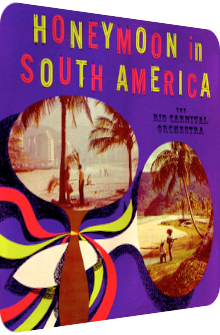
Rio Carnival Orchestra
Honeymoon In
South America
1958
Honeymoon In South America sees the 101 Strings rebranded as it happened several times over the course of their existence, depending on the specific needs, projects and outlooks. The collective of skilled instrumentalists has recorded three albums under the flamboyant name of Rio Carnival Orchestra, maybe due to the boosted amount of trumpeters and other brass players which became a more prominent part of these albums and seemingly took away the focus of the string concept too much.
Released in 1958 on David L. Miller’s Somerset label and housing ten compositions of various flavors, it is the quasi-debut for the renamed orchestra. The album title promises two things: a honeymoon and the visit of South American places. And the orchestra delivers these concepts, though the performance is not always mirrored by the title. Many arrangements are surprisingly dark and almost too threnodic for such a vacation-inspired album. People want their honeymoon to be paradisiac, exciting and whatnot, but comtemplation and anger should only occur years later in a marriage, if ever! Luckily, there are still many bustling and ebullient tunes on board which emit sunlight and tropical places. This is the task of Joseph Kuhn, frequent collaborator and writer for many a Somerset LP. He delivers three compositions that are specifically written for this album, all of them unique and awash with light. They turn out to be splendid counterparts to the cinematic seriousness which frequently occurs. Still, all is not lost, the album has its qualities, be it Pagan flutes, accordions in various tone regions, amorous tonalities or cavalcades of claves and other tonewoods.
The opener is one of the most successful transmutations in the world of Exotica, even though no one really cares about this notion, since the genre has been perceived as too strange for decades and the Rio Carnival Orchestra’s album has faded to obscurity, no matter its recent reissue galore. Anyway, the rendition I am talking about is of Orchids In The Moonlight. Originally written by Edward Eliscu, Gus Kahn and Vincent Youmans, the orchestra alters the Polynesian core, strips off the archetypical Easy Listening alloy… and makes an entire turnkey Latin corker out of it. The strings yearn ins sunset-red colors, the high notes of the marimba seem like water droplets, the injected Tango rhythm emanates besotted devotion, and last but not least, it is the brass players who tower above the dusky scenery, severely augmenting the melancholy of this otherwise strangely oscillating piece. The arrangement itself may be forgettable if one does not notice the gradual shift of the orchestra, and it is not even particularly catchy per se, but the shift in tone and atmosphere is noteworthy nonetheless.
Honeymoon Cha-Cha is a different ditty altogether and the expected U-turn. Written by said longtime collaborator Joseph Kuhn whose state as a luminary will forever be questioned and toned down due to the better-known vivid mind of Les Baxter, the mood is decidedly uplifting and tropical: crystalline piano aortas, delicate pizzicato string undercurrents and echoey claves make up the base frame of the arrangement and allow the sun-kissed horns to shine. Maybe this is going to be a joyous honeymoon indeed.
Or maybe not. Jacob Gade’s and Vera Bloom’s Jalousie is yet another reversion and lets the album fall back to the swamps of passionate murkiness. Running for over five minutes, this centerpiece of side A is as cinematic as its first appearance in 1925, but is probably only considered due to the 1945 flick Anchors Away starring Frank Sinatra. The accordion is a lead instrument on the album version, bringing a little Portuguese breeze to the album. Otherwise, there is not much to say about this composition. It is unfortunately too dark which becomes an even greater pity once the Tango-oriented chorus brightens up and includes the turquoise marimba specks that already graced the opener. The traditional Florita then barely crosses the two-minute mark and functions as a much feistier, quicker take on the traditional tune. The admixed accordion is now polyphonous, the alto flute melody is of the Pagan kind, and the short infusions of castanets, clinging tambourines and other iridescent percussion instruments allows for a bubbling undulation aquiver with joy.
The last composition of side A is Tango De L’Amour, and despite its bog-standard title, is in fact another unique composition by Joseph Kuhn with cleverly interspersed segues of placidity which sport a nylon string guitar and violins that much more resemble the clichés of Italy than those of South America. A generally more quiescent and fragile Tango than an example which is coated in grandiloquence or megalomania, Tango De L’Amour is still festive enough, but all too chintzy nowadays.
Side B harbors another five tracks, all of them comparably great, making this the better side of the two. Launching with a bucolic interpretation of Ary Barroso’s Brazil that unleashes a fusillade of clicking castanets, piercing strings and brass blebs, Sebastián Yradier’s La Paloma offers a new soundscape, at least by tendency. Strings there are on board alright, and yes, majestic brass fanfares gyrate in the background, but the majority of the runtime of over four minutes is used to let the accordion appear in the spotlight. And it really fits the overall mood, sounding less cheesy than one might expect. We are still not talking about the progressive territory of Dominic Frontiere, but the grained sound of the instrument does add something new to the album, notwithstanding the fact that the accordion appears several time in many arrangements.
The third time, meanwhile, is the charm, and so Joseph Kuhn offers another composition called Moon Over Montevideo, one of his classic vacation songs where the mood is not only insouciant, but severely hued in technicolor. This is by far the best song of the whole album! The ingredients are well-known, the claves are clicking like clockwork, the marimba droplets celebrate their encore, even mellifluous flute washes made it to the phantasmagoria, but the tonality and Space-Age strings make this more of a superb Easy Listening tune and less of a nocturnal jumble. A definite highlight. Whereas Moisés Simóns’ El Manicero (aka The Peanut Vendor) resembles the sound of a quartet most of the time via flutes, acoustic guitars as well as sweeping maracas and only breaks the illusion when lively brass bursts interpolate the sunny afternoon setting, the final La Cumparsita by Enrique Pedro Maroni, Gerardo Hernán Matos Rodriguez – gasp! – and Pascual Contursi returns to the lands of devotion, lust and love. The choice for a Tango rhythm comes naturally, and so the brass-infested accordion-accentuated string mélange moves farther into the night until the spinning disc comes to a halt.
Honeymoon In South America is too bold a title to be considered a classic in the realms of Exotica in general or David L. Miller’s Somerset potpourri in particular, but it occasionally shows glaring moments of genius and bliss, making the album worth the travelog fan’s while. I have pinpointed the opener Orchids In The Moonlight as such a moment which not only successfully transforms a beautiful moony Polynesian jungle serenade into a partially bewailing locale deep down in South American, no, it also manages to live up to the album title, at least in terms of the set of countries it wants to be situated in. Other highlights are regularly delivered by Somerset’s songwriter Joseph Kuhn whose Moon Over Montevideo is the album’s stellar monolith, towering above and beyond the hatched sanguine colors via its golden range of gleeful overtones and apt depiction of a wondrous weekend trip.
Honeymoon Cha-Cha is no less beautiful and based on the same premise. Listeners who really care for symphonic travelogs and their exotic tendrils as well as the concepts and organizations behind the album will probably raise a brow or two for yet another cheeky naming convention which almost seems like a ploy up to this point: Hamburg’s Philharmonic Orchestra was renamed to the 101 Strings, whereas the 101 Strings appear as the Rio Carnival Orchestra three times, and as if this were not dubious enough, there is an instance where the orchestra is yet again transformed and called the Trans World Symphony Orchestra on Edmond De Luca’s opus Safari (1958), but those listeners who are willed to elbow these marketing tactics away and love the darker, Latinized side of Easy Listening should check this honeymoon artifact out. This is easier than ever, as the vinyl version turns up regularly, with many remastred digital incarnations being sold at Amazon MP3, iTunes and readily available at streaming services.
Exotica Review 314: Rio Carnival Orchestra – Honeymoon In South America (1958). Originally published on Feb. 15, 2014 at AmbientExotica.com.
